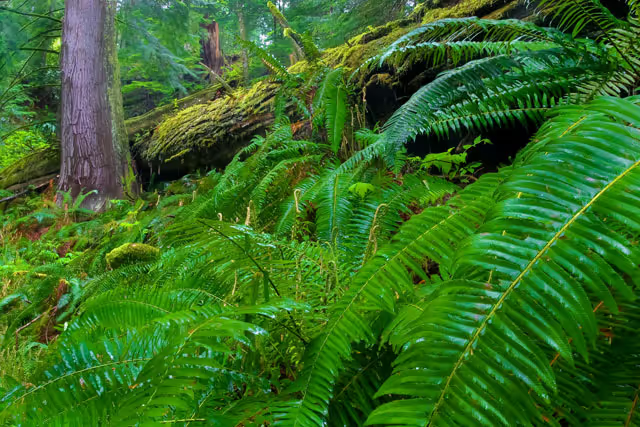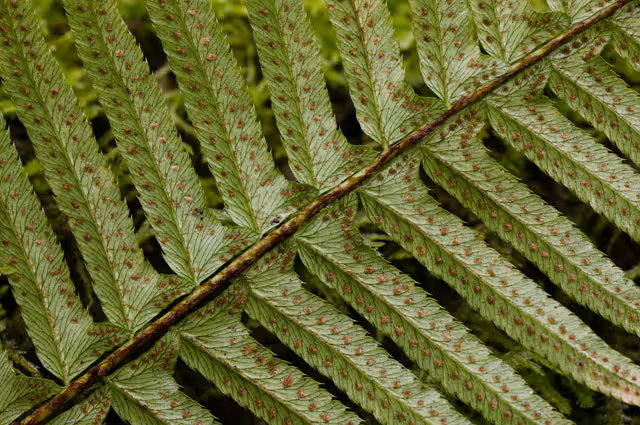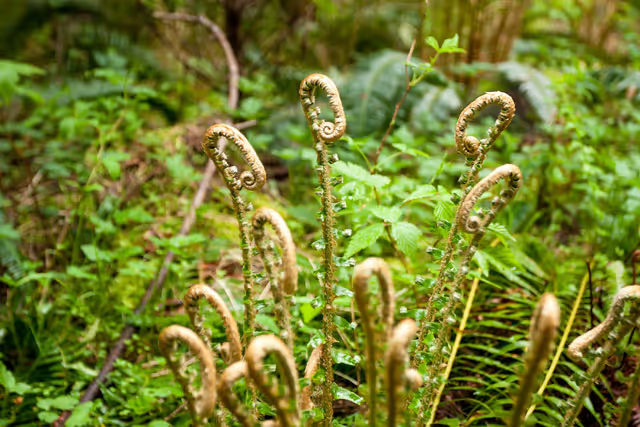Western Sword Fern, the “King of Northwest Ferns”


Try to imagine the first explorers to the Pacific Northwest. They followed Native American guides along time-worn paths through the misty, cool, and dark green forests. Coniferous trees towered above them; shafts of sunshine beamed through cleared areas. Vine maple, salal, huckleberries, currents and low growing bunchberry were just a few of the many plants they saw. And interspersed between all of these, were ferns.

Of over 40 varieties of ferns in the PNW, the six members of the Polystichums genus dominate. All are long-lived, large, and evergreen, and include the Western Sword Fern (Polystichum munitum). The Western Sword Fern stunned the explorers.Many old ferns, at 5’ tall, were taller than the short statured men. This sea of green surrounded the newcomers who probably gaped at the luxurious and multi-textured growth.
Now, however, we take this magnificent plant for granted. Many even consider it a weed!
Let’s take a closer look at this truly majestic plant and you can decide for yourself…
According to Plants of the Pacific Northwest Coast, by Jim Pojar and Andy MacKinnon (sold in Damon’s Outpost at the CIC), the Western Sword Fern grows in “moist forests at low to middle elevations; abundant and widespread from central Vancouver Island and adjacent mainland south…” They are especially prolific in the humid coastal forests in mild winter zones; thus, they grow abundantly in Ocean Shores. Specific adaptations allow them to flourish in other not so hospitable areas also. These include clear-cut areas and under power line rights-of-way.

Described as “large, evergreen, with erect leaves forming a crown from a stout, woody, scaly rhizome,” the Western Sword Fern is very long-lived and fire resistant. Fronds grow from the underground rhizome, appearing at ground level as a “fiddlehead” which uncurls to continue growing longer. The erect leathery fronds range from 8 to 98 inches long and generally arch as they lengthen. Each frond is a compound “pinnate” leaf, meaning it resembles a feather with each leaflet growing on a side of the common axis or rib of the frond. On the underside of the leaflets are large brown “sori” which are small spore cases.The fronds persist on the plant for several years, gradually shriveling before sagging and falling to the ground.
As an important part of the ecological forest cycle, the Western Sword Fern supplies cover to small animals including some birds and bedding for bear winter dens. Elk, deer, and beaver eat the fern.
Native Americans also used various parts of the sword fern in cooking processes such as wraps, for food and/or food storage, and flooring. Some communities used it in a traditional game. Medicinal uses included chewing leaves for sore throat, boiling the rhizome to make infusions for sores and eating the rhizome to cure diarrhea.

And speaking of eating… let’s talk about those “fiddleheads.” Native Americans are not the only ones who relished this delicacy. The fiddleheads are high in fiber and iron, supply omega-3 and omega-6 fatty acids and include antioxidant activity. Caution: be careful when collecting fiddleheads. A similar fern, Bracken Fern (Pteridium aquilinum) is toxic if not fully cooked.
If you decide to pick and eat fiddleheads, only harvest half of a plant’s fiddleheads. Taking more reduces the plant’s sustainability. Please check online for more information, cautions and cooking instructions.
Although the Western Sword Fern is all around us, it is one of the Pacific Northwest’s signature plants and a climate change indicator. It is a beautiful and useful plant and one which deserves our homage. Hail, “King of the Northwest Ferns.”
© Jacqui Austin, May 2021
Touch whale bones, examine shipwreck artifacts and connect with the coast's living history.

Support our mission, get involved in educational programs, or contribute through donations and volunteering.